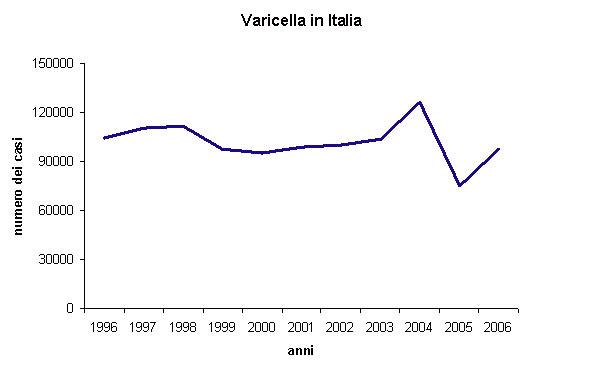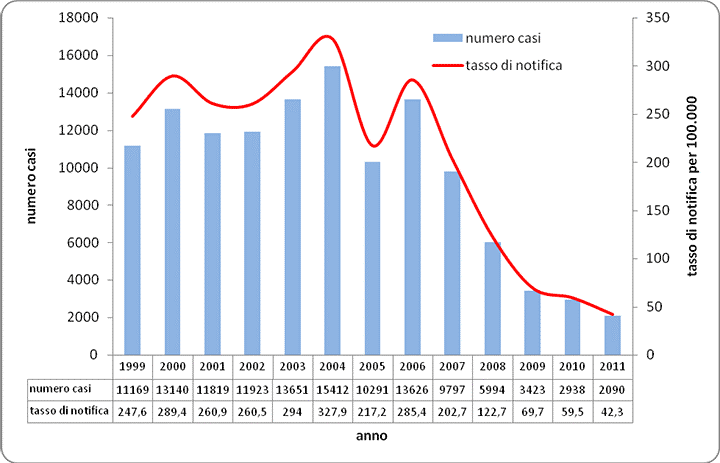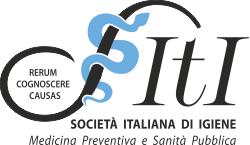The epidemiological curves comparing pre- and post-vaccination periods show a sharp decrease in the number of cases over the years. It is clear that vaccinations have significantly changed the incidence of diseases for which immunisation exists, thus saving lives, reducing disease outcomes, reducing overall population suffering and improving quality of life.
The disease before and after the vaccination campaign in Italy.
Varicella (chicken pox) is a highly contagious infectious disease caused by the Varicella zoster virus (Vzv) which belongs to the group of Herpes viruses. Along with rubella, measles, whooping cough and mumps, it is one of the contagious childhood diseases, which in most cases affect children between 5 and 10 years of age. When it affects adults, it is more likely to cause complications. In the first two trimesters of pregnancy, chickenpox can be transmitted to the foetus and can cause congenital varicella syndrome, which is potentially responsible for foetal malformations. The disease can be particularly severe if it affects immunocompromised individuals (people with HIV infection, those undergoing chemotherapy or under treatment with steroids for asthma or other diseases). It is rare for a person to develop this disease twice; however, the virus is not eliminated from the body, but remains latent (generally for life) in the ganglia of the spinal nerve roots. In 10-20% of cases the virus awakens years or decades later, usually after the age of 50, giving rise to Herpes Zoster, commonly known as shingles, which manifests as a cluster of vesicular-type lesions on the chest, sometimes accompanied by localised pain. Pain that lasts longer than one month is called postherpetic neuralgia.
Epidemiological data on the cases of varicella in Italy from 1996 to 2006 are available: the trend shows a series of oscillations within an essentially growing trend until the mid-1990s. The maximum number of cases reported in one year was over 126,000, reported in 2004. After this peak, there was a decrease in cases, especially after 2005, when many Italian regions, in particular Sicily and Veneto, introduced universal vaccination for all newborns.

In Italy, before 2005, vaccination was offered exclusively to subjects belonging to particular at-risk groups; that is, to susceptible individuals, specifically to family members of immunocompromised individuals, to subjects suffering from acute lymphatic leukaemia in complete remission, chronic renal failure, HIV infection with CD4 ≥ 25%, to women of child-bearing age, to health workers or those who work in schools. The 2005-07 National Vaccination Plan introduced the varicella vaccine into the vaccination schedule in regions that had a vaccination coverage for the MMR vaccine of more than 80%. Currently the situation appears heterogeneous: only seven Regions have adopted a universal vaccination programme against chickenpox aimed at susceptible children and adolescents. In the remaining fourteen regions, the vaccine is offered free of charge to all at-risk individuals and of these, nine provide vaccination even to susceptible adolescents. One of the objectives of the "2012-2014 National Vaccine Prevention Plan" is to achieve and maintain a vaccination coverage ≥95% for one dose of the anti-varicella vaccine by 2 years of age, and for two doses in children of 5-6 years of age and in adolescents, starting with the 2014 cohort.
The results obtained from the introduction of universal vaccination in some Italian regions are striking, as shown in the graph below for the Veneto Region in which anti-varicella vaccination for newborns was introduced in 2005.

As regards complications of varicella in Veneto, in the period 2000-2006 hospitalisations for complications were 34-44% of the total, decreasing to 27% during 2008. In 2008, three years after the introduction of the vaccine, there was an overall decrease of 59% in the hospitalisation rate and a decrease of 55% for 0-14 year-olds. The reduction in the hospitalisation rate for 1-4 year-olds was 74% demonstrating the major impact of vaccination, especially on the group targeted by the vaccination programme, but also on other age groups due to the effect of herd immunity.



